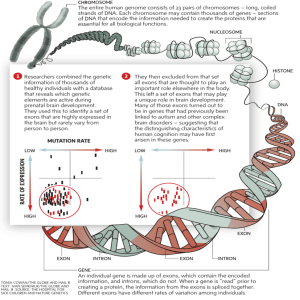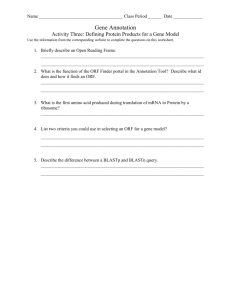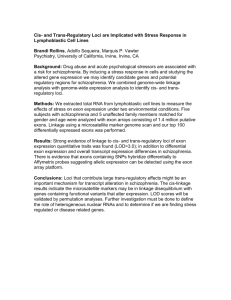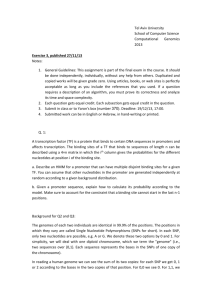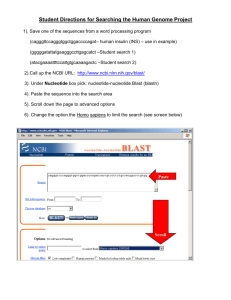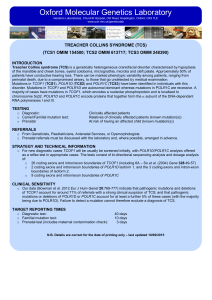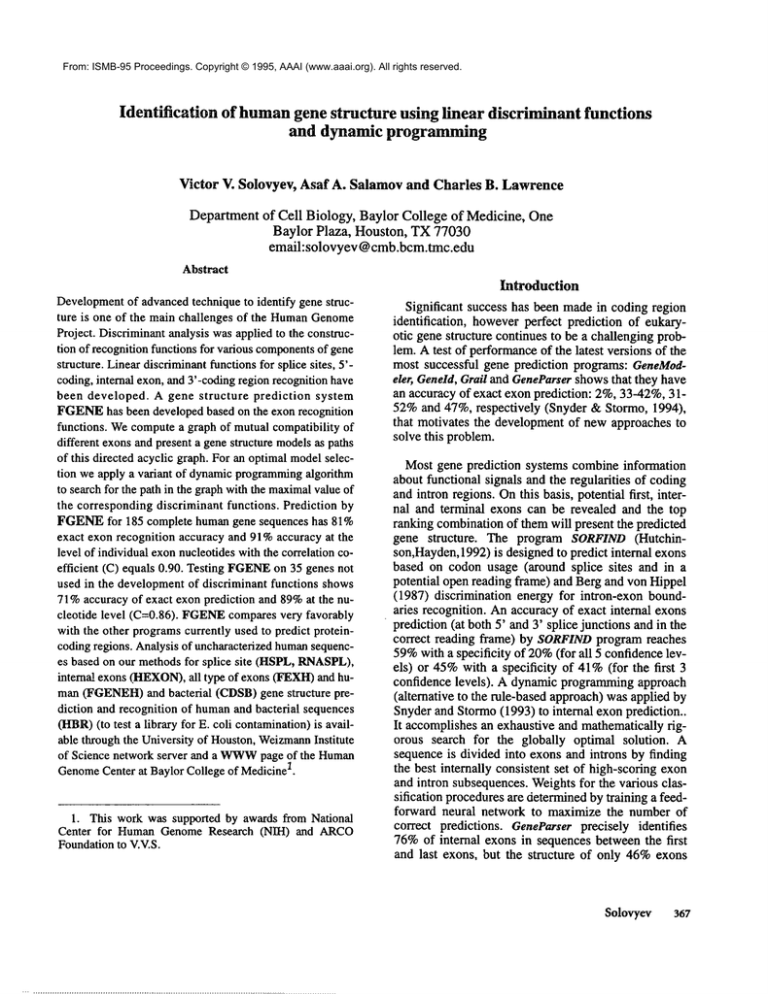
From: ISMB-95 Proceedings. Copyright © 1995, AAAI (www.aaai.org). All rights reserved.
Identification
of humangene structure using linear discriminant functions
and dynamic programming
Victor V. Solovyev, Asaf A. Salamovand Charles B. Lawrence
Department of Cell Biology, Baylor College of Medicine, One
Baylor Plaza, Houston, TX 77030
email:solovyev@cmb.bcm.tmc.edu
Abstract
Introduction
Developmentof advancedtechnique to identify gene structure is one of the main challenges of the HumanGenome
Project. Discriminantanalysis was applied to the construction of recognition functions for various components
of gene
structure. Lineardiscriminantfunctions for splice sites, 5’coding, internal exon, and 3’-codingregion recognition have
been developed. A gene structure prediction system
FGENE
has been developed based on the exon recognition
functions. Wecomputea graph of mutual compatibility of
different exons and present a genestructure modelsas paths
of this directed acyclic graph. For an optimal modelselection we apply a variant of dynamicprogrammingalgorithm
to search for the path in the graphwith the maximalvalue of
the corresponding discriminant functions. Prediction by
FGENEfor 185 complete human gene sequences has 81%
exact exon recognition accuracy and 91%accuracy at the
level of individual exonnucleotides with the correlation coefficient (C) equals 0.90. Testing FGENE
on 35 genes not
used in the developmentof discriminant functions shows
71%accuracy of exact exon prediction and 89%at the nucleotide level (C=0.86). FGENE
compares very favorably
with the other programscurrently used to predict proteincoding regions. Analysis of uncharacterized humansequences based on our methodsfor splice site (HSPL,RNASPL),
internal exons (HEXON),
all type of exons (FEXH)and
man(FGENEH)
and bacterial (CDSB)gene structure
diction and recognition of humanand bacterial sequences
(HBR)(to test a library for E. coli contamination)is available through the University of Houston, Weizmann
Institute
of Science network server and a WWW
page of the Human
GenomeCenter at Baylor College of Medicine/.
1. This work was supported by awards from National
Center for Human Genome Research (NIH) and ARCO
Foundationto V.V.S.
Significant success has been made in coding region
identification, however perfect prediction of eukaryofic gene structure continues to be a challenging problem. A test of performanceof the latest versions of the
most successful gene prediction programs: GeneModeler, Geneld, Grail and GeneParsershows that they have
an accuracy of exact exon prediction: 2%, 33-42%, 3152% and 47%, respectively (Snyder & Stormo, 1994),
that motivates the development of new approaches to
solve this problem.
Most gene prediction systems combine information
about functional signals and the regularities of coding
and intron regions. Onthis basis, potential first, internal and terminal exons can be revealed and the top
ranking combination of them will present the predicted
gene structure.
The program SORFIND(Hutchinson,Hayden, 1992) is designed to predict internal exons
based on codon usage (around splice sites and in
potential open reading frame) and Berg and von Hippel
(1987) discrimination energy for intron-exon boundaries recognition. An accuracy of exact internal exons
prediction (at both 5’ and 3’ splice junctions and in the
correct reading frame) by SORFINDprogram reaches
59%with a specificity of 20%(for all 5 confidence levels) or 45%with a specificity of 41%(for the first
confidence levels). A dynamic programming approach
(alternative to the rule-based approach) was applied
Snyder and Stormo (1993) to internal exon prediction..
It accomplishes an exhaustive and mathematically rigorous search for the globally optimal solution. A
sequence is divided into exons and introns by finding
the best internally consistent set of high-scoring exon
and intron subsequences. Weights for the various classification procedures are determinedby training a feedforward neural network to maximize the number of
correct predictions. GeneParser precisely identifies
76%of internal exons in sequences between the first
and last exons, but the structure of only 46%exons
Solovyev
367
was exactly predicted whentested on entire GenBank
entry sequences.
Wehave developed a program(HEXON)
for the prediction of internal exons of humangenes. The programis basedon a splice site prediction algorithmthat
uses a linear discriminant function to combineinformationabout significant triplet frequenciesof various
functional parts of splice site regions andpreferences
of oligonucleotides in protein coding and intron
regions (Solovyev, Lawrence,1993a; Solovyev, Salamov, Lawrence,1994a). For exon prediction, wecombine in a linear discriminantfunction 5 characteristics
describingthe 5’-intron region, donorsplice site, coding region, acceptor splice site and 3’-intron region
for each open reading frame flanked by GT and AG
base pairs. Theaccuracyof precise internal exonrecognitionon a test set is 77%with a specificity of 79%.
Therecognition quality computedat the level of individual nucleotides is 89%for exon sequences and
98%for intron sequences. HEXON
has a better exact
exonprediction accuracythan other internal exonprediction programs,but it is trained and tested on internal gene regions (including intron and internal exon
sequences)and maybe useful for analysis of partially
sequencedgenes.
To predict 5’- and 3’-flanking coding exons, the
FEXH(find humanexons) program has been developed (Solovyev, Salamov, Lawrence, 1994b). A discriminant function for 5’-exon prediction consists of
hexanucleotide compositionof upstreamregion, triplet composition around the ATGcodon, ORFcoding
potential, donor splice site potential and composition
of the downstream
intron region. Adiscriminant function for 3’-exon prediction included octanucleotide
compositionof upstreamintron region, triplet composition around the stop codon, ORFcoding potential,
acceptor splice site potential and hexanucleotidecomposition of downstream
region. Weunited 5’-, internal
and 3’-discriminant functions in exon predicting program FEXH.FEXHexactly predicts 70% of 1016
exons from the set of 181 completegenes with specificity 73%,and 89%exonsare exactly or partially predicted. On the average, 85%of nucleotides were
predicted accurately with specificity 91%.Although
FEXHcompares favorable with the other programs
currently used to predict coding exons (see reviewin
Snyder & Stormo, 1993,1994), this program shows
only the positions of candidate exons and does not
attempt to produce assembledgenes.
To date, GeneModeler
(Fields and Soderlund, 1990),
GenelD(Guigo et a1.,1992) and XGRML
(Xu et al.,
368 ISMB-95
1994) are integrated packagesthat predict gene structure from genomicDNA.The first two methodsrely
on revealing the functional motifs such as start and
stop codons,splice sites andpoly(A)signals; then
sequential filtering evaluation of the assembledcombination of a gene component.GenelDcan precisely
identify 54%of real exons with correct splice boundaries (Guigoet a1.,1992). XGRAIL
is the most widely
used of the codingsequenceidentification program.It
based on neural network recognizers of exon candidates, filtering themby a set of heuristic rules anduses
dynamicprogrammingapproach to build a gene models (Xuet al., 1994). Dynamic
programming
is used
find an optimal combination of preselected exons
(Gelfand, Roytberg, 1993; Solovyev, Lawrence,
1993b; Xu et a1.,1994), that is different from the
approach suggested by Snyder and Stormo(1993)
search for exon-intron boundarypositions. The result
of optimization by dynamic programmingand gene
structure prediction quality are clearly dependenton
exonrecognition and optimizational functions.
As mentioned above, an accuracy of exact exon
identification by gene prediction programs(including
XGRAIL)is less than or about 50%whenthey were
tested on the same data set of humangenes (Snyder, Stormo,1994).This stimulated us to developgene
structure prediction algorithm using our improved
splice site and exonrecognition functions (Solovyev,
Salamov,Lawrence,1994a,b). In the present work we
combinelinear discriminant analysis and dynamic
programming
approaches in our gene prediction system using the advantages of natural functional
description of the formerand fast rigorous searching
schemeof the later one (Solovyev,Lawrence,1993b).
Materials and Methods
The data sets
Wehavetaken all entries including completehuman
gene sequences from GenBank(release 81,1994)
(Cinkoskyet al., 1991). Someentries were divided
they had several genes in them. Whena gene had
alternative splicing variants, the first of themwas
selected. Entries with stop codonsin-frame of annotated codingregions and nonstandardsplice site conservative dinucleotides were discarded, due to
possible errors in their description. Thesize of the
resulting set was185 genes. The set has been used to
computeparameters of 5’ and 3’-exon discriminant
functions and thresholds of the main algorithm. A
similar procedurewas followed, this time using Gen-
a) Search for a group of potential internal exons
a
d
d
1
d2 3
I
1 I
Id
I I
a
d
b) Selection of 5’- and 3 ’-coding exons for each internal exon
Met
d
d
a
d
a
Stop
codon
a
Salamov, Lawrence, 1994b)
exon recognition which were
describedearlier.
We will explain the main
steps of the algorithm (Fig.I)
and demonstrate them for an
exampleof prediction for GenBank entry HUMILSA
(length
5191bp). The gene from this
entry has 4 exons localized in
the followingpositions:(1) 1584
1647; (2) 2464 - 2599; (3)
2871 - 2954 and (4) 3370
3385.
1.
IDENTIFYING
POTEN.
TIAL INTERNAL EXONS
th’~on
does
not
save
ORF
3’-exon 2 has a greater
LDFvalue than 3’-exon 1
c) Construction of a graph of compatibility of internal exons
1
1st ORF
2nd
3d
1 --> (3,5); 2 --> (3,4); 3 -->
d) Search for the path with maximal weight in the directed
acyclic graph by dynamic programming
The weights are the corresponding LDFvalues of predicted exons
First, wecreate a set of potential internal exons (Figure la)
using the linear discriminant
function (LDF~)for calculating
a score of any ORF(open reading frame) between any pair of
conservativesplice site dinucleotides AGand GT. Weuse the
threshold score 4.0 for accepting
of potential exon, whichis less
than the optimal for exon prediction without assembling
them. Further assembling will
remove manyof overpredicted
exon variants.In the HUMIL8A
sequence, 12 potential internal
exons were selected. Their positions and LDFvalues are given
in Table1.
Fig.1. Construction of gene models by dynamic programming
approach.
Bank84 release. A further 35 entries (having 1994 in
their LOCUS
description line) with complete genes were
thus identified, whichwe used to evaluate the performanceof the FGENEprogram.
The algorithm
A general schemeof our gene prediction algorithm is
shownin Figure 1 and realized in FGENE
program. We
build FGENE
based on linear discriminant functions of
internal (LDFtn)(Solovyev, Salamov,Lawrence,1994a),
5’- coding, and T-coding (LDF
s, and LDF~,)(Solovyev,
2.
RECOGNITION
OF POTENTIAL
5’-CODING
REGIONS
For each of the predictedpotential internal exon,
wesearch for possible 5’-codingregion with maximal LDF(Zs,
) value (Figure lb). Weconsider all
sequence regions having donor site conservative
dinucleotide GTlocated morethan 60 bp on the left
of the acceptor site of the correspondinginternal
exon and having a compatible ORFstarting with
Met codon. Fromthese sequences we analyze all
Solovyev 369
TABLE1. Predicted potential
exons for GenBank entry HUMIL8A.
4.
CONSTRUCTIONOF GENE
MODELS
N
Locationof
1
2
3
4
5
6
7
8
9
10
11
12
internalexons
1618- 1647
2464-2599
2871-2954
2878-2954
2892-2954
2892-2954
2894-2954
2894-2954
2896-2954
2896-2954
2914-2954
2914- 2954
LDFIn
LDF
6.1
9.5
14.3
13.9
10.2
10.0
9.8
9.7
6.7
7.0
5.6
5.4
ORF
optimal5’-exon
optimalY-exon
#
location(LDF)
Iocation(LDF)
3253-3275
(7.9)
3370-3385
(11.6)
3370-3385
(11.6)
3370-3385
(11.6)
4735-4797
(4.0)
33703385(11.6)
4735-4797
(4.0)
3370-3385
(11.6)
3370-3385
(11.6)
4735-4797
(4.0)
3370-3385
(11.6)
4735-4797
(4.0)
3
3
1
1
3
1
3
1
1
3
1
3
1584-1647
(10.5)
1584-1647
(10.5)
1584-1647
(10.5)
1584-1647
(10.5)
variants having the discriminant function (Zs,) value
more than 0.
For HUMIL8A
sequence only one potential 5’ exon
with location 1584-1647 and value of LDFZ5,=10.5
was predicted. In this example only exons 2,8,9 and
12 are compatible with the predicted 5’-exon 15841647 (Table 1). It must be noted that not each internal
exon will have a 5’-exon after this procedure.
3.
RECOGNITIONOF POTENTIAL 3’-CODING
REGIONS.
For each of the potential internal exons, we search
for possible 3’-coding region with maximal LDF(Z3,
)
value (Figure 2b). Weconsider all sequence regions
having acceptor site conservative dinucleotide AG
located more than 60 bp on the right of the donor site
of the corresponding internal exon and having a compatible ORFwith Stop codon at the end. From these
sequences we analyze all variants having the discriminant function (Z3,) value more than
For HUMILSAsequence 47 potential
3’-coding
exons were predicted; for example: (3370-3385) with
Z3,=l 1.6, (4735-4797)with Z3,--4.0, etc. All 12 internal exons have corresponding 3’-exons. For example
1st internal exon (1618-1647) compatible with 3’exon (3253-3275) with corresponding value Z3,=7.9.
Selected 3’-coding regions are given in Table 1.
370 ISMB---95
Each predicted exon can be characterized by: (1) the corresponding
value of LDF; (2) an assigned reading
frame rf { 1,2,3 }. Fromthe set of predicted internal, 5’ and 3’- exons it is
possible to construct a model of gene
structure for a given sequence. Note
that particular potential 5’- and 3’exons are assigned to each internal
exon, therefore we will consider
internal exon combinations as potential gene models. The case of gene
structure without internal exons will
be treated especially.
Assumethat we have array of internal exons ordered according with
their start positions in a analyzed
sequence. Let us define the term of
compatible exons. Any two (i-th and j-th) predicted
exons (i > j) are considered compatible if: (1)
exon localized downstream and the distance between
the end of exon i and the beginning of exon j is more
than the minimumintron length (60 bp); 2) ORF
these exons are compatible upon their merging, i.e.
after removing corresponding intron sequence ORFof
the i-th exon proceeds to ORFof the j-th exon and no
in-frame stop codons are observed.
Wedenote the graphical representation of compatibility of exons as an exon compatibility graph (ECG).
The nodes of ECGare internal exons and edges links
compatible ones (Figure lc). Note, that according
its definition ECGis a directed and acyclic graph.
This graph maybe presented by the list form:
1:3,5
2:4,5
3:5
4:
5:
The first exon is compatible with exons number 3
and 5; the second exon - 4, 5.; the third exon - 5. The
exons 4-th and 5-th have no compatible internal
exons.
Because of any gene model must consist of a subset
of compatible exons, we have to select this subset
from all possible groups of such exons. These groups
maybe presented as paths in compatibility graph.
Eachpath in this graph going through compatible
nodes can be characterized by a weight, which is
selected in this algorithm version as the sumof LDF
values of its constituent exons. If there is 5’-exon
compatiblewith the first internal exon of the path
(first node)and3’--exoncompatiblewith the last internal exon(last node), they are consideredas the first
and last nodes of the given path and their LDFvalues
added to the weight of path. For example, for path
goingthroughinternal exonsel, e2 ..... en . the total
weightof the genemodelis equal to:
n
W = ~ Zin(ei)
Z5(e0) +
Z3(e n + 1 )
i=1
whereZ/n, Z5, 7_,3 - LDFvalues of internal, 5’ and
3’-exons selected for eI and en exons, respectively.
Zs(e0) = 0, if the first internal exon1 have no compatible 5’-exonand Z3(en+l)= 0, if internal exonn
have no compatible3’-exon. Our goal to find a path
with the maximalWvalue amongall possible paths
through compatibleexons.
This optimization problem can be solved using a
dynamic programming approach to search for an
optimal path in acyclic directed graph (Solovyev,
Lawrence,1993). Wemodified one such algorithm,
described in (Cormen,Leiserson, Rivest, 1990), and
implemented it in FGENEprogram.
Let the numberof preselected internal exons is N;
MW(i)is the maximalweight subpath to node i, consisted of i and nodes predicessing i in ECG;P(i) is
the predicessingi nodeof this subpath; Ki is the number of exons compartiblewith exon i.
Initially
we
assign:
P(i)=O
and
MW(i)=LDFin(e~+LDFa(e
~. Then, for each node/,
starting from1, wecheck all his compatibleKi exons
(j=I,...,K~ and assign MW(j)=MW(i)+LDF(ej),
if
MW(i)+LDF(ej)
> MW(]).Also, in this case P(])=i.
Finally, the path with the maximalweightwill be finishing in node m, which has maximal value of
MW(i)+LDFa(e~,
(i=l,...,N). Using P(t) we restore
the set of maximalpath exons, by begining from the
terminal m. The numberof exon (]) predicessing exon
(i) isj=P(i).
The running time of this algorithm is O(n+m),
wheren - numberof nodes (potential internal exons)
and m - numberof edges (total numberof all links
betweencompatible exons) of the ECGgraph.
For our illustrative examplewe obtained a list of
compatible downstream internal exons, for each
internal exonfromTable 1:
1 : (2, 8, 10, 12)
2 : (3, 6, 7).
Thefirst exonis compatiblewith exonnumber2, 8,
10 and 12; the second exon - 2, 6 and 7. Exons3-12
have no compatibleinternal exons.
In the HUMIL8A
sequence example a path with
maximalweight goes through internal exons 2 (2464
- 2599) and 3 (2871-2954).Exon2 has a corresponding 5’-exon (1584-1647) with LDFs,=10.5and exon
3 has corresponding 3’-exon (3370-3385) with
LDF~,=I1.6. Therefore path through internal exons 2
and 3 has the following weight: W=10.5 +
9.5+14.3+11.-6=45.9.
Thus, for HUMIL8A
entry all componentsof annotated genestructure is precisely predicted:
1. 1584- 1647(5’-coding region)
2. 2464- 2599(the first internal exon)
3. 2871- 2954(the secondinternal exon)
4. 3370- 3385(3’-coding region).
For estimation of an algorithm performance we
will use the following measures(Fickett and Tung,
1993; Snyder, Stormo, 1993; 1994; Dong, Searls,
1994). Sensitivity (Sn) measuresthe fraction of
true examplesthat are correctly predicted and specificity (S)
P measures the fraction of the predicted
examplesthat are correct:
TP
Sn = TP + FN;
TP
SP - TP + Fp
Truepositives (TP) is the numberof correctly predicted and false positives (FP) is the number
falsely predicted authentic splice site positions (or
exons); true negatives (TN)is the numberof correctly
excluded and false negative (FN) is the number
falsely excludedpseudosite positions (or pseudoexons).
Correlationcoefficient (C) is an importantaccuracy
criterion that takes the relation betweencorrectly predictive positives and negativesas well as false positives and negatives into account (Matthews1975):
C
(TPx TN- FP x FN)
,,,I(TP + FP) (FP + TN) (TP + FN) (TN
Solovyev 371
Results and discussion
Basedon the foregoing discriminant functions two
coding region prediction algorithm have been developed. The FGENEH
algorithm (described above)
builds gene model based on searching an optimal
combination of compatible exons. In addition, we
have developed a computer program FEXH
(Solovyev, Salamov, Lawrence, 1994b), which predicts a set of codingexons in a given sequencewithout assembling them. The programinitially predicts
internal exons based on internal exon discriminant
function. Thenit searches for 5’-codingregion starting from the beginningof the sequenceuntil the end
of the first predictedinternal exon.In this regionthe
5’-coding exon with the maximalweight of the first
exon discriminant function is selected. After that we
search for 3’-coding region starting fromthe beginning of the last predicted internal exonuntil the end
of the sequence. In this region the 3’-coding exon
with the maximalweightof the last exon discriminant
function is selected. FEXH
is less sensitive to underprediction of an exon, that can significantly distort
the obtained gene model.
We analyze the performance of FEXH and
FGENEIton training (185 genes) and new test (35
genes) sets of humanentry sequences. The results of
prediction are presentedin Table2.
At the level of complete exon sequences, FEXH
precisely identifies 611 of 755 (81%)internal exons
on the training and 116 of 168 (69%)on the test set.
Theaccuracyof 5’ and 3’ exonsis significantly less,
than internal. It exactly predicts 17 of 35 (49%)5’exons and 19 of 35 (54%)3’-exons from the test set
sequences. At the nucleotide level Sn=85%,Sp=79%
and C=0.8for the test exonsequences.
Someof predicted pseudoexon ORFsare removed
in a gene structure predictive system FGENEH
due to
assemblingprocedure, that improvesthe accuracy of
prediction. It precisely identifies 916 of 1125(81%)
exons from the training set and 168 of 238 (71%)
exons from the test set sequences. At the nucleotide
level Sn=89%,S~=88%
and C=0.86for the test entry
sequences. We~ave compared the performance of
FGENEH
with the results of GRAIL-2and XGRAIL
programs. GRAILis the most widely used of the coding sequenceidentification programand showsbetter
or similar quality on entry sequences (compare to
GeneModeler, Geneld, GeneParser or GenLang
algorithms) for different test data (Snyder,
¯ Stormo,1994; Dong,Searls,1994)). GRAIL-2can be
used via Emailserver to test the wholegeneset and
XGRAILcan construct a gene model by "optimal"
assemblingsomeof predicted exons.
372
ISMB-95
Wecan see that the current version of FGENE
has accuracymuchbetter than GRAIL.2,especially
in exact exon prediction (- 20%more accurate).
Thehigher accuracyis probablybased on quality of
our splice sites recognizers, whichare moreaccurate than the others known.
The GRAILX-Windows(XGRAIL) version with
modelconstruction has been applied to the prediction of gene structure of the set of new35 genes.
Their sequences were not used in FGENE
as probably well as in XGRAIL
training. Weselect the best
XGRAIL
predicted modelfor the accuracy estimation. Theaverageprediction results are presentedin
Table 2. Wecan see that the current version of
FGENE
predicts exactly 71%of 238 real exons,
but XGRAILthe best model predicts only 48%
ones. Results of prediction for each test gene are
given in table 3. This results showthe XGRAIL
accuracy similar with reported by (Snyder and
Stormo, 1994).
Thus, our approach has better performance on
newtest sequences. Moreover,wedo not use special heuristic rules for exonselectionin this variant
of gene prediction, in distinction with the GRAIL
algorithm. It mustbe noted, that higher accuracyof
coding region prediction might be reached if ORFs
of analyzing sequence have somesimilarity with
knownprotein sequences. In such case it is very
fruitful to use this informationduringexon selection (Gish,States,1993), but present consideration
devotes primarily to prediction of newgene structures, which have no significant similarity on
nucleic as well as protein level in the current data
bases.
Oneof the hardest problemof gene prediction is
identifying 30-60 bp exons in 100000bp of bulk
DNA.FGENEperforms well on such examples.
There are 13 GenBankentry sequences from our
test set that have less than 9%of the sequence
occupied by protein coding regions. For example,
entry HSZNGP1 9823 bp has 9% coding
sequences, and FGENE
predicts all its exons; entry
HUMFMR1S
61613 bp has only 3% coding DNA,
and FGENE
predicts exactly 14 of its 17 exons.
Computationalaspects
FGENEH
is implementedin Fortran 77 and runs
on Sun Spare and DECAlpha workstations.
FGENEH
is quite fast for analysis of usual gene
size sequences (5000 -10000 bp). Searching average gene structure in themtakes about 1 minon an
Sun SparcClassic workstation. However,analysis
of sequence of about 200000bp takes 10 min on
TABLE
2. The performance
of FEXH,
FGENEH
andGRAIL
on the training andtest sets. Snex°n andSpex°n are the
sensitivity andspecificity of exactexonprediction;SnnedandSpnudare the sensitivity andspecificity of total exon
nucleotldeprediction;C-correlation
coefficient.
trainingentryset
~.on
S~e
test entryset
p.
SnCXO
eNOII
Sp
85%
nud
Sp
79%
C
0.80
Sn*r~
FEXH
72%
62%
88%
SpnUCt C
80%
0.82
FGENEH
81%
78%
91%
91%
0.90
71%
67%
89%
88%
0.86
GRAIL2
50%
55%
82%
87%
0.82
45%
68%
71%
88%
0.77
48%
71%
71%
86%
0.73
eXOB
Sp
Snnttcl
XGRAIL
DECalpha computer. The maximal size of an input
sequence 200000is installed in the current version of
FGENEH.The size of compatibility
graph matrix
has to be approximately NxN/3, where N is the number of predicted potential
internal exons. Now
FGENEpermits N up to 1000 and this is enough for
analysis of tested 200000 bp sequence. The search
time for predicting potential internal exons grows linearly with sequence length. The memoryrequirement
of the program and run time increase with the square
of the numberof potential internal exons.
Gene~Finder services
Using the methods presented in our papers we
developed a set of sequence analysis programs which
are useful for various aspects of gene discovery. The
group includes the following programs: splice site
prediction (HSPL); recognition of exon-exon junction in eDNA(RNASPL),which is useful for selecting optimal PCRprimers in internal exon regions
during gene sequencing, when starting
with a
sequence of cDNAclone; internal exons (HEXON)
and all type of exons (FEXH) prediction;
human
gene structure prediction (FGENEH); bacterial
gene structure prediction (CDSB) and recognition of
humanand bacterial sequences (HBR)to test a library
for E. coli contamination by sequencing example
clones. Analysis of uncharacterized sequences based
on our methodsis available through the University of
Houston network server by sending the file containing a sequence to service@bchs.uh.edu with the subject line hspl, rnaspl, hexon, fexh or fgeneh or "man
fgeneh" to receive instructions about the sequence
format. Duringthe first monthof this server installation
(October, 1994) about 600 requests for sequenceanalysis
have been received. These programs are also installed
64%
55%
in WeizmannInstitute of Science server:
vices@bioinformatics.we&mann.ac.il.
ser-
Gene-Finder programs can be found on World
Wide Web through the BCM Human Genome
Center Search launcher Homepage (Fig.2) URL:
http: // kiwi.imgen.bcm.tmc.edu:
8088/searchlauncher/launcher.html for access to Gene-Finder and Secondary structure prediction Help files
and programs. There were about 1200 times someone ran a gene-finder script through WWW
for the
first 3 monthsof 1995.
Bibliographyof literature
Berg, O.G., von Hippel, P.H. 1987. Selection of
DNAbinding sites by regulatory proteins.
J.Mol.Biol., 193, 723-750.
Cinkosky,M.J.; Fickett, J.W.; Gilna, P.; Burks, C.
1991. Electronic Data Publishing and GenBank.Science 252: 1273-1277.
Cormen,T.H., Leiserson, C.E., Rivest, R.L. 1990. Introchtction to Algorithms.M1TPress.
Dong,S., Searls, D.B. 1994Genestructure by Linguistic methods. Genomics,23,540-551.
Gelfand, M.S., Roytberg, M.A. 1993. Prediction
of the exon-intron structure by a dynamic programmingapproach. BioSysten~s, 30, 173-182.
Gish, W., States, D. 1993. Identification of protein
codingregions by database similarity search. Nature
Genetics, 3,266-272.
Guigo, R.; Knudsen,S.; Drake, N.; Smith, T. 1992.
Prediction of gene structure. J.Mol.Biol. 226: 141157.
Solovycv
373
Table 3.The comparison with the best XGRAILgene model using 35
test entry sequences presented to GenBankin 1994. Eex is the number
of exact predicted exons, Cnu
c is the correlation coefficient computed
based on prediction at the level of individual nucleotides.
XGRAIL
FGENEH
GenBank
Length
Nex
ENTRY
Eex
Cl, luc
Eex
ClrlUC
HSABLGR1
35962
8
0
0.00
3
0.61
HSCYCLA
8363
8
0
0.44
5
0.92
HSDAO
9903
4
3
0.80
3
0.85
HSHLADMAG
5190
5
2
0.91
1
0.81
HSHLADMBG
6933
6
3
0.86
5
0.97
HSNCAMXI
16288
28
23
0.96
21
0.85
HSU01102
4995
3
1
0.07
2
0.91
HSU04636
9453
10
4
0.69
9
0.85
HSU05259
5670
5
3
0.91
4
0.76
HSUHSU07807
4839
3
0
0.00
2
0.37
HSU08198
2344
7
5
0.98
5
0.94
HSUBR
3321
3
0
0.18
2
0.85
HSZNGPI
9823
4
3
0.88
4
1.00
HUMCSN2A
10608
6
2
0.57
0
0.77
HUMDZA2G
14694
4
2
0.87
3
0.99
HUMFMR
1 S
61613
17
4
0.56
14
0.86
HUMGAD45A
5378
4
2
0.79
3
0.84
HUMGCK
7807
10
8
0.96
8
0.94
HUMHPARS
1
11551
7
5
0.97
5
0.86
HUMIBP3
10884
4
4
1.00
4
1.00
HUMIGERA
7659
5
1
0.71
3
0.71
HUMLHDC
32351
12
5
0.85
8
0.85
HUMMCHEMP
2776
3
3
1.00
3
1~0o
HUMMET2
1703
3
1
0.84
3
0.84
HUMMGPA
7734
4
1
0.70
1
0.60
HUMMHCP42
5141
10
9
0.99
10
1.00
HUMMHHLA
3810
7
3
0.84
3
0.85
HUMOSTP
10881
6
3
0.90
5
0.95
HUMPBGDA
10024
14
4
0.67
9
0.82
HUMPLA
2967
5
5
1.00
5
1.00
HUMPYYPI
1935
3
1
0.94
1
0.79
HUMREGHOM
5
1
0.62
4
0.97
HUMRPIB2
3411
4337
5
1
0.63
4
0.97
HUMTBGA
8769
4
1
0.79
3
0.85
HUMTPALBU
6172
6
2
0.70
3
0.68
238
48%
0.67
71%
0.86
Average:
374
nucl.
ISMB-95
Fickett, J.W.; Tung, C.S. 1992. Assessment of Protein Coding Measures. Nucl.
Acids Res. 20: 6441-6450.
Fields, C.; Soderlund, C.A. 1990. gm:a
practical tool for automating DNAsequence analysis. CABIOS6: 263-270.
Hutchinson, G.B., Hayden, M.R. 1992.
The prediction of exons through an analysis of spliceable open reading frames.
Nucl.Acids Res. 20:3453-3462.
Mathews, B.W. 1975. Comparison of the
predicted and observed secondary structure of T4 phage lysozyme. Biochem.Biophys.Acta 405: 442-451.
Snyder, E.E., Stormo, G.D. 1993. Identification of coding regions in genomic DNA
sequences: an application of dynamicprogramming and neural networks. Nucl.Acids Res., 21:607-613.
Snyder, E.E.,Stormo, G.D. 1994, Identifying genes in genomic DNAsequences.
To appear in Nucleic Acid and Protein sequence analysis: A practical Approach,
Secondedition (in press).
Solovyev, V.V., Lawrence, C.B. (1993a)
Identification of Humangene functional
regions based on oligonucleotide composition. In Proceedings of First International conference on Intelligent System
for Molecular Biology (eds. Hunter L.,
Searls D.,Shalvic J.), Bethesda, 371-379.
Solovyev, V., Lawrence, C. (1993b) Prediction of humangene structure using dynamic programming and oligonucleotide
composition In: Abstracts of the 4th annual Keck symposium. Pittsburgh, 47.
Solovyev, V.V., Salamov,A.A., Lawrence,
C.B. 1994a. Predicting internal exons by
oligonucleotide composition and discriminant analysis of spliceable open reading
frames. Nucleic Acids Res. 22, 24, 51565163.
Solovyev, V.V., Salamov, A.A., Lawrence
C.B. 1994b. The prediction of human exons by oligonucleotide composition and
discriminant analysis of spliceable open
reading frames. In Proceedings of the Sec-
ond International Conference on Intelligent
Systems for Molecu-
lar Biology (eds. Altman R., Brutlag D., Karp P., Lathrop R.,
Searls D.), Stanford, CA, 354-362.
Xu, Y., Einstain, R.J., Mural ,R., Shah ,M., Uberbacher, E.C. An
improved system for exon recognition and gene modeling in Human DNAsequences. In Proceedings of the Second International
Conference on Intelligent Systems for Molecular Biology (eds.
Altman R.,Brutlag D.,Karp P.,Lathrop R.,Searls D.), Stanford,
CA, 376-383.
Fig. 2. WWW
Gene-Finder
:::::::::::::
.............................................................
f.
.................................................................................
:’::’:::::ISI:?: ........ i? : ’.::"’:’: ’:::~:+::":::::"::::::"~"
~.:.........;~:~:~:~:~:~:~:~:~:~:~:~:~:~:~:~:~:~:~:::~:~:~::~:~:~:~:::~
~~E~~~~~~~h~~h~!~::::: :::::::::::::::::::::::::::::::::::::::::::::::::::::
"~:~
:
_e~ o_~r~_NavCgate
L0motate_Oocumera~
D°cument
Title: !
DocumentURL:
%
i
¯ Sp~esl~i Protein¢odi~exom
andG~enmdel
constriction
.............
L-m,o page, where you can past
your sequence, run the programsand read the results
andhelpfiles.
CutandpasteDNA
sequenc~
here(sequence
only):
gctggsagatggtcact gtt tg cgcgatca~J~
ggatgaagat acacact tccgcgcgaccag
agcgggat¢actt tactg¢cagcgct J~
~ggt
Sequenc~name/ldmdfl~.
chooses~-chn~e~hoa
for Hun~
sequence
an,~:
[H][O][F]-[H]:He..tFld.eacd?don;
[0 ].’f~ Op~on$
search;
[P]:sa~cb.Parc-nat.s
4~ FGENI~
I eor, stnmtlonof~enemodelbY~n asr,~.~ [_H.] Eq] [.P]
v FEXHtsearchIorpolemialS’-,irttemalard3’-eotU~e~mas
L~.] [_0][?l
~, HEXONtsearchfcrpot~tialinternal~-nns LH]L0j LP]
~, HSPL/s~forpo~ea]sp]~sl~
[.HI [_Q] [P_]
RNASPL
/ search for ¢zon-~u~-,junction positions in eDNA
LH_]
v CDSB
/ s~trchfor Protein¢~dingregionht E.coli LH.]
-~. HBRlr~gnitZcnofHumsna~IF,.colls~lu~mLH]
_~_a@
_to_
p_c~
.s.
_e~__
_da_
_L
_a~_
__eh_er
_H_
.~9~..
_~
_a~e_
PageCurator.Victor V~dowev,
Depcztmentof Cell Biotogy, ~lor Collegeof Meda’cine
s o towe v@cm
b ~ zqnc_~l~
B~ ~ Ho.meJReload
,Y.v;¢~
I Open
Save As...JCloneJ
NewWlndow
I CloseW~ndew
I
.~~-.-;*.~.:.:._._._._._._._._..v~.,-~.-.-----.----.-...-.-.-.
.......::::: ........... -.-:-::~:::.-....-.~.-.~-±:’,~-_.,.-.
....... ¯ ...........................
:. :....-’.’..’.. -,_,:
Solovyev
375

